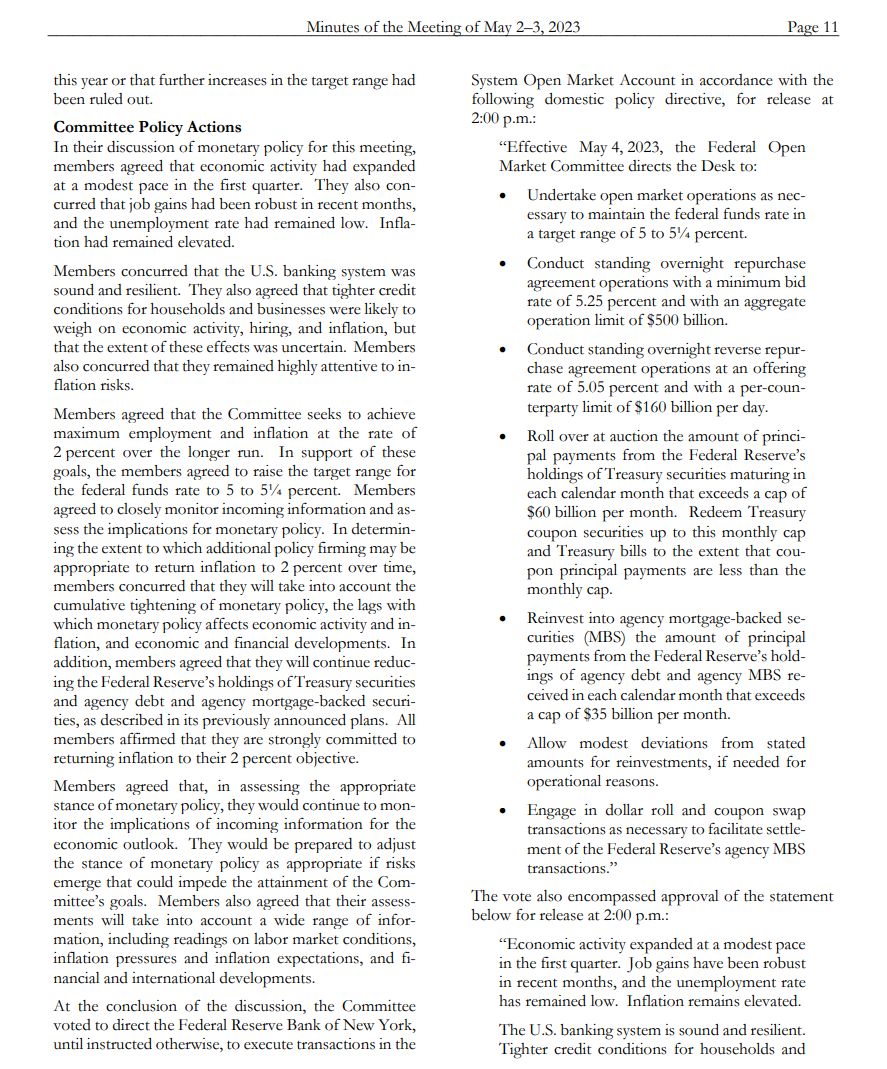Rate cut hopeless?Minutes of May Fed policy meeting: Upcoming information needs to be closely monitored
On May 24, the Federal Reserve released the minutes of the May meeting of the Federal Open Market Committee (FOMC).。According to the minutes, Fed policymakers have disagreed on the future of monetary policy, and some members have already raised the possibility of suspending interest rate hikes at their next meeting。
On May 24, the Federal Reserve released the minutes of the May meeting of the Federal Open Market Committee (FOMC).。According to the minutes, Fed policymakers have disagreed on the future of monetary policy, and some members have already raised the possibility of suspending interest rate hikes at their next meeting。However, both sides did not agree on this and stressed the need for more data to support its next policy move, and did not hint at the possibility of a rate cut.。

Specifically, in discussing the current state of the economy, participants noted that economic activity expanded at a moderate pace in the first quarter.。However, job growth has been strong in recent months, unemployment has remained low and inflation remains high.。In addition, participants agreed that the US banking system is healthy and resilient。They commented that households and businesses face increasingly stringent credit conditions that could have an impact on economic activity, employment and inflation.。Against this backdrop, participants agreed that they remain highly vigilant about inflation risk。
In assessing the economic outlook, participants generally expected real GDP growth to be below its long-term trend rate in 2023 due to the impact of restrictive financial conditions.。In addition, they judge that banking pressures may further affect economic activity, but the extent of this impact remains highly uncertain。With inflation still above the Committee's long-term 2 per cent target and core inflation showing only partial signs of easing, participants expected that a degree of below-trend GDP growth and a period of labour weakness would be needed to achieve a better balance between aggregate domestic demand and aggregate supply.。
However, participants also said that the actions taken by the Federal Reserve and other government agencies in response to the banking crisis have eased the pressure on the industry。They noted that conditions in the banking sector had improved broadly since early March, with initial deposit outflows experienced by some regional and smaller banks slowing sharply in subsequent weeks.。Still, they were unable to assess at this point how much impact the event could have on economic activity.。
In assessing the U.S. household sector, participants noted that consumer spending was strong in the first quarter as it was supported by growth in personal disposable income.。They also noted that the quarter's strong performance was largely driven by very strong spending growth in January, but that actual spending fell slightly in February and March.。They also expect consumer spending to grow at a lower rate for the rest of 2023, largely reflecting the impact of tighter financial conditions over the past year.。However, some members observed that the high frequency of measures of consumer sentiment related to banking development had not yet shown significant changes。
In the business sector, participants said that business fixed investment underperformed in the first quarter, reflecting relatively high borrowing costs, weak output growth in the business sector and growing concern among businesses about the overall economic outlook.。Participants expect the tightening of bank lending standards to be a further drag on corporate capital spending。Several participants have already pointed out that, according to reports from their regional contacts, concerns related to banking stress could add more uncertainty to the already weak economic outlook, increasing caution among businesses, especially small and medium-sized businesses that rely on bank credit to fund their operations.。
On the job market, panelists said the labor market remained tight, as evidenced by strong wage growth and near-historically low unemployment in March.。However, they also noted some signs that the imbalance between supply and demand in the labor market is weakening. In addition, some participants also noted that contact recruitment in their regions has become less difficult, employee turnover has decreased, and there have even been some layoffs. Job growth is expected to slow further, reflecting the adjustment of aggregate demand, partly due to tighter credit conditions.。participants generally expected that under the appropriate monetary policy, the imbalance in the labor market would gradually decrease and the pressure on wages and prices would gradually ease。
In discussing the specific monetary policy for May, officials at the conference agreed that the current inflation rate is still too high。According to the minutes, officials believe that indicators of inflation through March, especially core inflation, have fallen too slowly in recent months。In addition, participants stressed that core non-housing services inflation showed little sign of slowing over the past few months.。
Overall, at that meeting, members agreed that current inflation remained high relative to its long-term target of 2 per cent.。Economic activity expanded at a modest pace in the first quarter, and the labor market remains tight.。While banking issues may have a negative impact, the scope and extent of the impact is currently uncertain.。Against this backdrop, all participants considered it appropriate to raise the target range for the federal funds rate by 25 basis points。
However, in discussing the outlook for future monetary policy, members appeared to be divided。
According to the minutes, some participants noted that further policy tightening may be needed at future meetings, building on expectations that progress towards a return to 2 per cent inflation may continue to be slow.。And several participants said that if the economy develops according to their current outlook, there may be no need for further policy tightening after this meeting.。
In response to the disagreement, the two sides said: Given the significant risks to the Commission's employment maximization as well as price stability objectives, participants generally agreed on the need to closely monitor upcoming information.。
It is reported that before the next interest rate decision, the United States will also release the main data are: the United States first quarter GDP data, May unemployment rate data, May non-farm data, May manufacturing PMI data, May non-manufacturing PMI data, as well as May CPI and PPI monthly rate.。Of course, for this meeting, the Fed is probably most concerned about the U.S. core PCE data for April.。
Chris Turner, an analyst at ING, said the Fed minutes reinforced expectations of another rate hike this summer, supporting the dollar.。"In the minutes, there was little comfort for the dollar bears, except for some remarks that were unsure of the need for further monetary tightening.。The minutes were "pretty tough" and hinted at another rate hike as policymakers acknowledged that inflation remains unacceptably high and slower than expected, making it "very likely" that markets will price the Fed another 25 basis points hike by July.。

Eagle Statement: This article is for reference only and does not constitute personal investment and operational advice.。Special reminder, the article is original content, without permission may not be reproduced。
·Original
Disclaimer: The views in this article are from the original Creator and do not represent the views or position of Hawk Insight. The content of the article is for reference, communication and learning only, and does not constitute investment advice. If it involves copyright issues, please contact us for deletion.